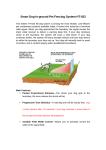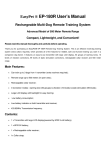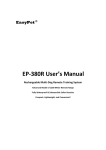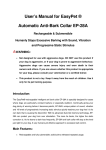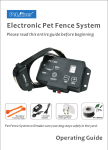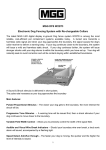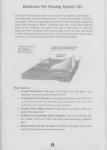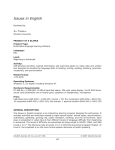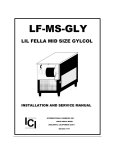Download Smart Dog In-ground Pet Fencing System
Transcript
EasyPet Rechargeable & Waterproof Pet Fencing System EP-8000 This EasyPet Rechargeable & Waterproof EP-8000 Pet Fencing System is among the most reliable, cost-efficient pet containment systems available today. The newly-designed submersible collar receiver guarantees that this system can be used safely under all weather conditions. A buried boundary wire transmits a harmless electromagnetic signal. When you dog approaches the boundary, the signal causes the dog’s collar receiver to deliver a single warning tone (beep) with vibration first. If your dog continues closer to the boundary, the system will issue more intense warning tones together with vibration correction. If your dog continues further, the system will emit a mild pulsed stimulus (shock correction), followed by stronger pulsed stimulus until your dog returns to within the boundary your have set up. Your dog will naturally seek to avoid correction, and is content staying within established boundaries. (Note: For EP-8000 fencing system, you can select tone & vibration triggering only without shock corrections. But you cannot select shock correction on its own.) Main Features: • Progressive Tone & Vibration Stimulus—A warning beep tone with vibration will be issued first, and more intense beep tones with vibration will be followed, then a pulsed stimulus if your dog continues to move closer to the boundary; • Pulsed Proportional Stimulus—The closer your dog gets to the boundary, the more intense the shock will be (there are two levels of pulsed stimulus); • Collar Receiver Unit Rechargeable & Fully Waterproof— The collar receiver is rechargeable and fully waterproof (submersible). • Large LCD Display—Large LCD screen on the transmitter for clear triggering distance setting & wire break indicators. • Variable Triggering Distance Setting—Allow you to precisely control the width of the signal field for both warning tone (vibration) and pulsed stimulus. • Audible and Visual Wire Break Indicators—Should your buried wire ever break, a sonic alarm will sound accompanied by a flashing symbol on the LCD screen. • Speed Detect Anti-Run Through—The faster your dog is moving, the quicker the higher level of intensity is issued; • Built-in Lightning Protection—Protects transmitter from power surges caused by lightning strikes; • Multiple Collar Operation—Add as many collars as you like to contain as many animals you have. There is no limit to the number of collars it can control. • Long Distance Boundary Wire Support—This system can support up to 800-meter-long wire installation (a 200-meter wire roll is supplied by default). Should you require extra boundary wires to cover larger areas, please contact your local dealer for supply. Package Contents: • 1 x Indoor wall-mounted transmitter with large LCD display; • 1 x Power plug; • 1 x Adjustable collar receiver (with short prongs fitted); • 1 x Charger plug for collar receiver unit. • 1 x Boundary wire of approximately 200 metres; • 1 x Pair of long metal prongs. • 20 x Training flags; • 1 x Test bulb; • 4 x Main box installation screws; • 4 x Twist-on wire connectors (Wire nuts); • 1 x Supplied magnet (to switch on/off collar receiver); • 1 x User’s manual. Other items you may need: • Screwdriver; • Straight edged spade or a lawn edger; • Wire stripping pliers; • Electrical tape; • Waterproofing compound (e.g. silicone caulk); • Patching compound for your type of driveway or sidewalk; • PVC pipe if crossing a gravel or dirt driveway, pond or lake; • Pencil, Ruler or Protractor; • Drill with drill bit or masonry bit if drilling through wood or concrete; • Additional Boundary Wire and extra wire connectors; CAUTION Please take a few minutes to read the instruction manual prior to your first use. For best results, follow these important rules: • Allow your dog to get used to the collar before you begin training. You want your dog to accept the collar as part of a routine, not to associate the collar with correction. • DO NOT leave the collar on your dog for more than 12 hours per day. • NEVER perform set-up procedures when the collar is on your dog. • An electronic collar should only be used under close supervision by the dog's owner. • KEEP OUT OF THE REACH OF CHILDREN. • Read all instructions before using this product. IMPORTANT Realize that because individual dogs have unique temperaments, there is no way of knowing how your dog will react to its introduction to this product. For the safety of your dog, initial training should take place using a long leash to keep you in control of the situation. Also realize that an aggressive animal could turn against the handler upon receiving the stimulus. Therefore, if you feel your dog has an aggressive behaviour and/or it has a history of aggressive behavior, you should consult a certified animal behaviorist before using this product. SECTION 1 INSTRUCTIONS FOR SETTING UP YOUR CONTAINMENT SYSTEM STEP 1 PREPARE A LAYOUT OF YOUR CONTAINMENT AREA A. Design and Draw Diagram Prepare a diagram of the area you want to contain your dog. A diagram will help to avoid unforeseen obstacles. Include the location of house, driveway, pond, garden, swimming pool, etc. If your neighbour has a containment system installed, mark the location of the buried wire on your diagram. B. Contact Utility Company Contact your utility companies to mark any buried utility lines. Be sure to include the buried lines on your drawing because these utility lines will affect the placement of your wire. C. Determine Location of Wall Transmitter The transmitter can be mounted to a wall near any standard 240-volt household outlet with the included screws. It will withstand freezing temperatures, but it is not waterproof. Therefore, it is best to locate the transmitter in an enclosed area. Install the transmitter at least three feet from any large metal objects such as breaker boxes, water heaters, metal garage doors, or washer and/or dryer. When installing the transmitter make sure the wire is not cut off or pinched by a window, door or garage door. When drilling holes, make sure there are no electrical wires, nails or screws inside the area you are drilling. D. Determine the Exit Route of Your Boundary Wire from the Transmitter to the Outside Containment Area Since your transmitter must be mounted in an enclosed area to protect it from the weather, give careful consideration on where the wire exits to the exterior. Existing openings such as a window, door or utility line hole may provide easy access to the outside. You may need to drill a hole through the exterior wall. STEP 2 ADD PROPOSED WIRE LOCATION TO YOUR DRAWING Mark your diagram with the proposed location of your wire. This will provide an easy reference as you install the wire. For the system to work properly, the wire must make one continuous loop. The signal is transmitted from one terminal of the transmitter, through the wire and back to the other terminal. Example Installation Diagrams Zones within Zones Basic Single Wire Zone Keeps your pet safely away from gardens, pools, and other areas. Dual Zones Your pet has a 360 degree perimeter to roam within. Open Back Zone Keep pets separated, or to prevent run-thru. Single loop - Back Yard Zone This lets your pet have access to the lake or other rear area. Single Loop - Front Yard Zone Your pet has run of the house and back yard. Double Loop - Back Yard Zone Your pet has run of the house and front yard. Double Loop - Front Yard Zone Your pet has run of the house and back yard. Front & Rear Barrier Zones Your pet has run of the house and front yard. Side Barrier Zones Your pet has full access to both sides, Your pet has full access to the front but not to the front or rear. or rear, but not to the sides. IMPORTANT NOTES FOR WIRE PLACEMENT: • Do NOT run the wire less than 20 metres under any occasions. Do NOT turn the any triggering distance setting to maximum when the wire is just over 20 metres, otherwise it will burn the wall transmitter (1/3 of triggering distance setting is maximum). Wire MUST be over 100 metres if you need to turn the triggering distance setting to maximum. If required wire is shorter than 100 metres, it will be safer to run double or even triple loop to make the layout wire over 100 metres. • Do NOT run the loop within 3 meters parallel to electrical, telephone, cable TV, or other buried wire in the yard. If you must cross electrical wires, telephone wires or television cables, do so at 90 degree angles. • Do NOT run one section of wire within 3 meters of another section or the signal may cancel. • Do NOT run your wire within 3 meters of any adjacent containment system’s wire. • Do NOT run your wire within 3 centi-meters of any steels bars under concrete ground otherwise signal strength will be reduced. STEP 3 ESTIMATE THE AMOUNT OF WIRE NEEDED EP-8000 model includes approximately 200 meters of good quality boundary wire. The amount of wire needed is determined by several factors: (a) Total area to be contained; (b) Using a double loop. This requires twice as much wire. (c) Size of the signal field. The signal field is the distance from the wire to the place where the collar receiver first activates. A 3 to 4 meters wide field is preferred. STEP 4 INSTALL THE WALL TRANSMITTER Install the wall transmitter close to a standard 240-volt household outlet. Do not plug the transmitter to the outlet until the boundary wire is in place. IMPORTANT NOTE: We recommend that you unplug the transmitter and disconnect the fence wire during lightning storms. STEP 5 LAY OUT THE PERIMETER WIRE IMPORTANT NOTE: Do NOT bury the wire until you have tested the system and are sure it is working properly. Do NOT nick or scrape the wire during installation. Improper function may result. 1. Use your drawing as a reference. Begin laying the wire around the perimeter of your containment area to form a continuous loop. Use gradual turns at the corners with a minimum of one meter radius. This provides a more consistent signal field. 2. If you are using more wire than initially supplied with your containment system, the wire connections must be waterproof to provide a sealed connection between the wires. 3. Continue around your perimeter until you return to the start of the loop. 4. Cut the wire. STEP 6 CONNECT THE PERIMETER WIRE TO THE WALL TRANSMITTER The wire from the perimeter to the wall transmitter should be twisted to cancel the signal. This allows the dog to cross the area without receiving a correction. It also eliminates possible interference from electrical wires, etc. 1. Measure the distance from the wall transmitter to the edge of the perimeter wire. 2. Because twisting the wire decreases the length of the wire, multiply the distance by 1½. 3. Measure and cut two wires of equal lengths of the above measurement. 4. Hold the two ends of the wire side by side and twist them together. The wires can be twisted manually until the twists are 6 to 12 cm apart. The tighter the wire is twisted the better the signal cancellation. 5. Pull the twisted wire to the perimeter location of the two ends of your boundary wire loop. Splice the ends of the twisted wire to the ends of the boundary wire ONLY with waterproof splices. 6. Put the twisted wires through the existing opening or drilled hole so it can be connected to the transmitter. 7. Strip off about 1 cm of insulation from the end of each twisted wire. 8. Insert the wires into the wire connector and insert the wire connector into the boundary wire socket on the transmitter. 9. Plug the power adapter into a standard 240-volt household outlet. 10. Connect the power adapter to the transmitter’s power jack. STEP 7 VERIFY TRANSMITTER IS FUNCTIONING PROPERLY To verify the transmitter is functioning properly, the LCD screen should display the warning tone and pulse correction triggering distance setting properly. There should not be any wire break indicator warning sign on the LCD screen or any warning tone from the transmitter. STEP 8 CHARGE & SWITCH ON/OFF THE COLLAR RECEIVER (Caution! Always use the supplied power adaptor to charge the receiver.) Lift the small rubber tab on the receiver to access the charger port. Plug the supplied wall charger to into the wall socket and into the charger port of the receiver. A red LED light is visible on the receiver during charging. When it is fully charged, the LED light on the receiver will flash red and green in turns until the plug is removed from the wall socket. Please charge the receiver for up to two hours for the first time use. After that, batteries discharged through normal use will take around one and a half hours to fully recharge. Do not charge receiver in especially hot area. Please remove the power plug from the wall socket when the receiver is fully charged. Please cover the charging port with the rubber tab tightly after charging. When the battery is low, the LED light on the receiver will flash red. Please charge the receiver as soon as possible. Signals to the receiver may be inconsistent. The collar receiver will enter sleep mode when there is no movement from the dog for more than 3 minutes. To switch on the collar receiver unit, simply put the supplied magnet onto the collar unit where the silver rectangle mark is, the collar receiver unit will bleep once to indicate that it is switched on. To switch off the collar receiver unit, put the supplied magnet onto the collar unit where the silver rectangle mark is again, the collar receiver unit will bleep three times to indicate that it is switched off. To increase the battery life, we recommend you to switch off the collar receiver when it is not in use. IMPORTANT NOTE: Do NOT place the collar receiver on your dog until the containment system has been tested and the signal field adjusted. If your dog has to leave the authorized zone, you must remove the collar receiver from your dog or switch off the transmitter. STEP 9 TEST THE CONTAINMENT SYSTEM DO NOT TEST THE CONTAINMENT SYSTEM WITH THE COLLAR RECEIVER ON THE DOG. You must manually test the containment system to verify that the signal is properly transmitted through the wire. Use the supplied test light. Select a section of straight boundary wire that is at least 20 meters long. Attach the supplied test light to the receiver probes and hold the collar receiver at your dog’s neck height. Slowly walk the collar toward the boundary wire. Listen for the warning tone (& vibration) and watch for the test light to light. The wider you can make the containment field, the less chance your dog can run through. Adjust the FIELD WIDTH as necessary and test again. Test in a number of different areas until you are satisfied there are no wire breaks and the system is functioning properly. Next walk all around the “safe” part of the yard to ensure there are no stray signals, particularly near the twisted wire coming from the transmitter. Test collar in and around the inside of the house as well. Signals from Cable TV, electrical or telephone lines can “couple” causing stray signals inside and outside the house that can activate the dog′s collar accidentally. If you do encounter this phenomenon, your boundary wire is probably too close to these outside lines and will need to be moved or modified. Containment collars should not be worn inside the house. STEP 10 ADJUST TRIGGERING DISTANCE SETTINGS Before allowing your dog into his play area, you will need to physically evaluate the extent of the authorized zone. Make sure your dog has enough space to move freely with the defined limits. The wider the zones, the lower the escape risks. Therefore, you have to find a good compromise between zone width and freedom space. NOTE: To switch on the transmitter: The transmitter is switched on by default when it is plugged in. You can also manually switch it on by pressing and holding down the warning tone triggering distance Increase “+” button for 5 seconds. It will beep and then the LCD display will light up. To switch off the transmitter: You can switch off the transmitter by pressing and holding down the warning tone triggering distance Increase “+” button for 5 seconds. It will beep and the backlight on the LCD display will flash for 3 times and then go off. When you switch off the transmitter, the triggering distance settings will be memorized. Next time when you switch on the transmitter, the settings will be last selected. But if you disconnect the transmitter from the power supply, the settings will not be stored. There are two type of triggering distance settings that can be adjusted on this model. The first setting on the LCD screen is the warning tone (&vibration) triggering distance setting. In a 200-meter wire installation, the triggering distance can be adjusted from around 0.8 meters (minimum setting) to 14 meters (maximum setting). In an 800-meter wire installation, the triggering distance setting can be set from around 0.2 meters (minimum setting) to 4 meters (maximum setting). The second triggering distance setting on the LCD screen is the pulse correction triggering distance setting. In a 200-meter wire installation, the triggering distance can be set from around 0.5 meters (minimum setting) to 12 meters (maximum setting). In an 800-meter wire installation, the triggering distance setting could be set from around 0.2 meters (minimum setting) to 3 meters (maximum setting). Follow the instructions in Step 10 to test the signal field width. Walk the entire perimeter to be sure that the signal field is consistent throughout your containment area. The signal field should extend a minimum of 2 meters on either side of the wire (creating a 4 meter wide field). A 3 to 4 meter wide field is preferred. The wider the signal field width, the less chance that a dog can run through the field. IMPORTANT NOTE: The warning tone (& vibration) triggering distance setting should be always longer than the pulse correction triggering distance setting. When you increase the pulse correction triggering distance setting, if it is bound to exceed the warning tone (& vibration) triggering distance setting, the system will automatically increase the setting of warning tone (& vibration) triggering distance. STEP 11 INSTALL THE BOUNDARY WIRE The boundary wire can be placed on the ground, buried (maximum 7cm to 10cm deep) or fixed to a non metallic existing fence or wall (best height: your dog’s neck height). If you are going to bury the wire, please make sure your installation is working properly before doing so. Tools Needed - Straight-edged spade, wire cutter / stripper, and standard screwdriver. If you plan to run the wire across concrete, you will also need a caulk gun, silicone caulking, and a circular saw with a masonry blade. Burying the Wire - The wire does not have to be buried, but for protection you probably want to bury it at least one inch underground. Start by digging about 5cm to 7cm deep where the wire first enters the ground near the transmitter and continue around the path of the loop wire. Note: When covering a large area, you may wish to use a trenching machine to cut into the ground. However, we recommend that the wire be placed in the trench by hand. A commercial wire-placing machine may break the wire. Driveways / Sidewalks - When crossing an asphalt driveway, make a 2 cm deep cut across the driveway using a circular saw and masonry blade. Place the wire in the crack and seal with asphalt sealant. On driveways and sidewalks, if an expansion joint is available, simply place the wire in the joint and seal with an outdoor caulk. When crossing gravel, bury the wire at least 7 cm deep. Use an old garden hose or plastic PVC piping to protect the wire. In water, anchor the wire with large rocks. Protect the wire with an old garden hose or plastic PVC piping. STEP 12 INSTALL THE BOUNDARY TRAINING FLAGS After installing the wire, retest the containment system as described in Step 9, Test the Containment System. Verify that the signal field width is consistent by following the instructions in Step 10. Adjust Triggering Distance Settings. As you are retesting and verifying the system, install the boundary training flags. Place the flags where the warning tone is first heard as you approach the wire. The flags should be placed at the edge of the signal field width, not directly on the wire. This will add a visual cue to the audio warning tone and help your dog to learn the boundary. STEP 13 FITTING THE COLLAR TO YOUR DOG IMPORTANT NOTE: Never leave the collar receiver on the dog for longer than 12 hours a day. Leaving the collar on the dog for extended periods could result in skin irritation. Check your dog's neck periodically for skin irritation. A. Probes • Make sure both probes contact the dog's skin. If needed, a small amount of hair removal or trimming will improve probe contact with the skin. • Use short probes for short-haired dogs. Use long probes for longhaired dogs. • Finger-tighten the probes, then turn them one additional revolution. Do not over-tighten. • Check the tightness of the probes regularly to prevent loss of the receiver box. B. Collar Strap • To prevent accidental correction inside the home, remove the collar from the dog’s neck when it comes inside. • Place the collar around the dog's neck with the receiver box under the chin. The collar must be on relatively tight to keep the probes making skin contact without restricting breathing. You should be able to slide only one finger under the strap at the back of the dog's neck. • Always make sure the collar is functioning properly BEFORE putting it on the dog. • Remove other metal collars when the dog wears the containment collar. Metal collars may interfere with proper operation. • Remove the collar and trim the excess strap. SECTION 2 HOW THE CORRECTION WORKS 1. Pre-Correction Warning Tone & Vibration: When the dog reaches the edge of the warning tone (& vibration) triggering distance setting, it will hear a warning tone (single beep) with vibration, followed by more intense beeping with vibration if the dog goes further. If the dog does not return to the safe part of the yard, it will receive a continuous correction until it returns to the safe area. 2. Run-Through Prevention: The receiver automatically increases the correction as the dog enters the signal field. The dog cannot "run through" the signal field without receiving a strong correction. SECTION 3 TRAINING YOUR DOG To get the most out of your containment system when training, keep these tips in mind: • • • • • To prevent accidental correction inside the home, remove the collar from the dog’s neck when it comes inside. Always make sure the collar is functioning properly BEFORE putting it on the dog. Verify the system is operating properly and the field width is appropriate as described in Section 1, Step 10. Adjust Triggering Distance Settings. Stay positive and playful during the training session. Keep training sessions brief. Never continue a session after your dog has lost interest. Take a break to rest or play. ALWAYS praise your dog for good behaviour. The following steps outline a successful training plan: STEP 1 FLAG TRAINING 1. Turn the wall transmitter “off” so no corrections will be given to your dog. 2. Place the collar receiver on your dog. 3. Place a long leash on your dog. Play with your dog in the safe area of the yard for 2-4 minutes. Do not allow your dog to run free or cross the flag lines. 4. Walk towards the flags. Reach down and shake a flag. Say "bad flag" in a disapproving tone. 5. Return to the centre part of the yard and play with your dog. Reward with treats. 6. Repeat this exercise several times in various locations of the yard. STEP 2 THE FIRST CORRECTION 1. You need to reset the signal field width before placing the collar receiver on your dog. Follow the instructions outlined in Section 1, Step 10, Adjust Triggering Distance Settings. 2. Place the collar receiver on your dog in the safe area of the yard. 3. Place a long leash on your dog. Play with the dog in the safe area of the yard. 4. Walk towards the flags. If your dog tries to avoid the flags, praise and reassure your dog. 5. Repeat this step in other locations of the yard. 6. Allow no more than three corrections in a day or seven in a week. This depends on your dog’s stress tolerance. Most dogs only receive a few corrections during the training phase; they respond to tone very quickly. 7. Reward your dog when it avoids the flags, even if a correction is issued. 8. Play in the safe zone with your dog before ending this training session. STEP 3 ON-LEASH PROOFING 1. With the collar on your dog and the wall transmitter “on”, play with your dog (on leash) in the safe area. After a few minutes of play, toss a toy or treat through the flags.10 2. If your dog runs through the flags to chase the toy, wait for the startled response and pull your dog back into the safe area. Praise and reward your dog. 3. Reinforce training by shaking a flag. Say "bad flag" with a disapproving tone. Consider increasing the signal field area. If you choose to increase the signal field area, remove the collar from your dog, increase the signal field, and retest. Refer to Section 1, Step 10, Adjust Triggering Distance Settings. 4. Repeat this exercise in other locations of the yard. 5. Praise your dog when it avoids the flags. Stay positive and playful during the training session. 6. When your dog refuses to run through the flags 20 consecutive times, proceed to the next step. STEP 4 OFF-LEASH PROOFING 1. Follow the instructions in Step 3, On-Leash Proofing except drop the leash on the ground. It will be available if you need to retrieve your dog. 2. If your dog gets through the signal field during this phase, quickly remove the collar. Bring your dog back into the safe area. Put the collar back on your dog. Reinforce "bad flag" training. Praise and reward your dog. 3. Repeat this off-leash training until you are confident that your dog will ignore temptations outside the containment area. SECTION 4 SYSTEM MAINTENANCE TIPS Your system requires very little maintenance. The rechargeable collar receiver is fully waterproof and can be used in all weather conditions and even under water. The wall transmitter is not waterproof and must be protected from the weather. A close lightning strike may damage the unit. Unplug the transmitter and disconnect the wires during storms. Do not attempt to dismantle or repair any of the system components; this will void the manufacturer’s warranty. Test the system once a week to make sure the collar receiver is working properly. Also, testing the system will verify the field width setting is correct. To test, attach the supplied test light to the collar receiver probes. Holding the receiver by the case, NOT by the probes, walk into the signal field. Listen for the warning tone to sound and the test light to illuminate. SECTION 5.11 TROUBLESHOOTING GUIDELINES A. Dog is not responding to correction: • Adjust the collar fit. • Trim the dog’s hair or use longer probes to make better skin contact. • Change the battery in the collar receiver. B. System Test Procedure: Whenever you experience a malfunction, you will need to do a Test Loop to determine which component - collar, wall transmitter, or yard wire - is not working. To perform the Test Loop procedure: 1. Make a test loop using a piece of wire at least 20 meters in length. 2. Remove the existing wire from wire connector on the wall transmitter. 3. Insert the two ends of the test loop into wire connector. 4. Set the triggering distance to a low setting. 5. Place the test light on the collar receiver. With the collar in hand, move outside the field and approach the test loop. Make a mental note of the distance between the collar and the wire when the collar activates. 6. Set the triggering distance to a medium setting. 7. Back away from the wire and approach it again. Determine the distance between the collar and the wire when the collar activates. The distance should be greater on the medium range setting. 8. If more than one collar receiver is used with the system, repeat the above test on each collar. Results of System Test Procedures: If there is no display on the LCD screen, the wall transmitter is malfunctioning. If the LCD display on the transmitter is working properly, but the collar receiver does not activate on the test loop wire, the collar receiver is not working. Try to charge the collar receiver and repeat the test. If a wire-break sign is on the LCD display and warning tone is emitted from the transmitter the problem is in the yard wire.


















